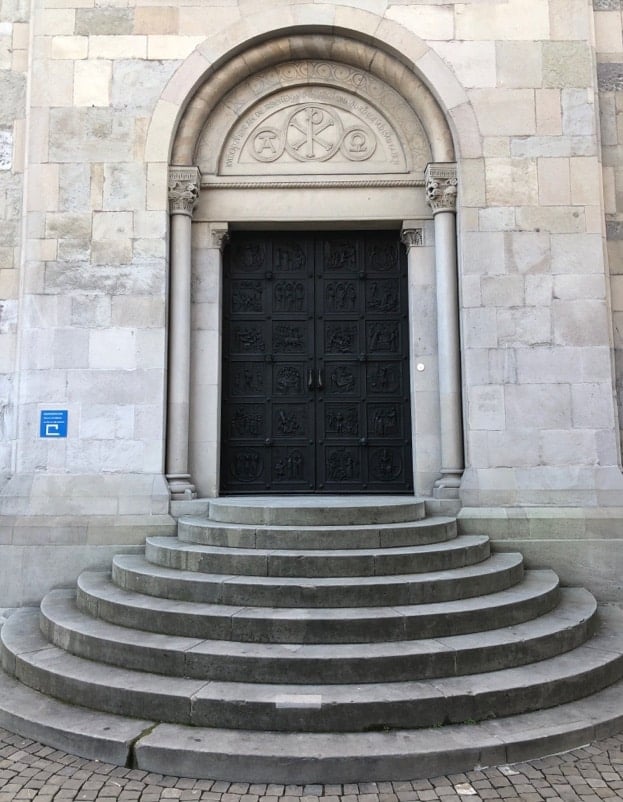Introduction to Grossmünster
The city of Zürich, Switzerland’s largest city and a global center for banking and finance, is home to an array of stunning architectural wonders. Among these, the Grossmünster stands as one of the most iconic landmarks in this historic metropolis. This Protestant church holds not only religious significance but also immense historical importance that dates back to the early Middle Ages.
A Glimpse into History
The origins of Grossmünster can be traced back to Charlemagne, the King of Franks who was instrumental in uniting much of Western Europe during the Early Middle Ages. Legend has it that he discovered graves of Felix and Regula – Zurich’s patron saints – on this spot and ordered a church to be built here.
In reality though, archaeological evidence suggests that construction began around 1100 AD or possibly earlier. The Romanesque-style cathedral played a significant role throughout history – especially during Swiss Reformation in 16th century when Huldrych Zwingli initiated radical reforms from his base at Grossmünster.
Architectural Splendor
Grossmünster consists primarily of three parts: two identical towers (known locally as ‘the pepper shakers’), nave with side aisles and cloistered courtyard. Its unique twin-tower design sets it apart from other churches within Zurich’s skyline.
The interior is marked by simplicity reflecting Zwingli’s philosophy about removing distractions from spiritual contemplation. You won’t find ornate decorations common in Catholic cathedrals; instead you’ll witness clean lines with minimal embellishments which create an atmosphere conducive for quiet introspection.
Climbing up for Panoramic Views
For those who are physically fit and not afraid of heights, a climb up the 187 steps to the top of one of the towers is highly recommended. At a height of 62 meters, it offers breath-taking panoramic views over Zurich’s Old Town, Lake Zurich and even as far as the Alps on clear days.
Artistic Highlights
Despite its austere interior design, Grossmünster does house some remarkable art pieces. The stained glass windows in particular are worth noting – while some date back to Middle Ages, others were created by renowned Swiss artist Augusto Giacometti in 1930s and Sigmar Polke in 2009.
In addition to this, you can also explore crypt housing a monumental statue representing Charlemagne. This sculpture was added much later – around late nineteenth century – but adds another layer to church’s historical narrative.
The Sound of Music
Grossmunster is also home to an impressive organ that was installed during extensive renovations between 1955-60. With its four manuals and pedalboard controlling over five thousand pipes spread across seven divisions, this instrument has been used for numerous concerts and recitals since then. For music lovers visiting Zurich it would be quite an experience attending such performances amidst historic surroundings!
Conclusion
A visit to Zürich would be incomplete without stepping into Grossmünster – whether you’re drawn by history or architecture or simply wish for quiet contemplation within city’s hustle-bustle! Its enduring presence serves as a testament not only to city’s rich past but also Switzerland’s commitment towards preserving their cultural heritage.
Frequently asked questions
What are the opening hours of Grossmünster in Zürich?
The Grossmünster church is open to visitors from 10:00 AM to 5:00 PM during the months of March through October, and from 10:00 AM to 4:00 PM between November and February. However, these timings can vary depending on special events or religious services taking place at the church. It’s always a good idea to check their official website for any updates before planning your visit.
What is the historical significance of Grossmünster?
Grossmünster plays a significant role in Zurich’s history as it was here that Huldrych Zwingli started the Swiss-German Reformation in the early 16th century. This Romanesque-style Protestant Church was supposedly built on the graves of Felix and Regula, Zurich’s patron saints who were martyred for their Christian beliefs. The construction began around 1100 and completed around 1220 AD, making it one of Zurich’s oldest churches with an intriguing past.
Is there an entrance fee to visit Grossmünster?
Entry into Grossmünster is free; however, if you wish to climb up its towers for a panoramic view over Zurich cityscape, there is a small fee involved – CHF5 for adults and CHF2 for children under-12 years old.
Are guided tours available at Grossmünster?
Yes, guided tours are offered by trained professionals who provide extensive insights about this historic monument’s architecture, art pieces like stained glass windows designed by Sigmar Polke & Augusto Giacometti along with its rich history related to Swiss reformation movement led by Huldrych Zwingli. These tours are available in multiple languages including English, German, French and Italian. However, due to COVID-19 restrictions, it’s recommended to check the current status of guided tours on their official website.
What other attractions can be explored near Grossmünster?
Besides exploring Grossmünster’s historical charm and stunning views from its towers, you can also visit nearby attractions like Zürich’s old town (Altstadt), Lake Zurich promenade for a leisurely walk or boat ride. Kunsthaus Zürich – an important modern art museum is close by too. For shopping enthusiasts and food lovers, Bahnhofstrasse – one of the world’s most exclusive shopping avenues and Sprüngli café renowned for Swiss chocolates & confectioneries are within walking distance from the church.









